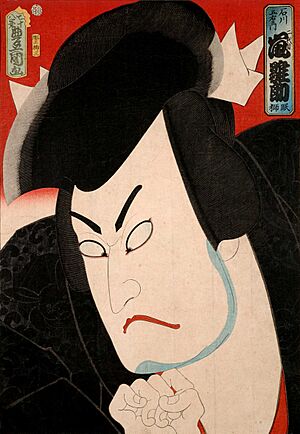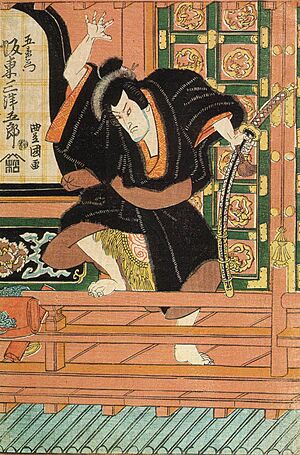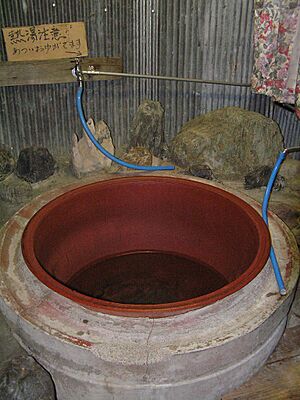Ishikawa Goemon facts for kids
Quick facts for kids
Ishikawa Goemon
石川 五右衛門 |
|
|---|---|

Goemon as played by kabuki actor Arashi Hinasuke II (an 1863 painting by Toyokuni III)
|
|
| Born | August 24, 1558 |
| Died | October 8, 1594 (aged 36) |
| Cause of death | Execution by boiling |
| Nationality | Japanese |
| Occupation | Thief |
Ishikawa Goemon (born August 24, 1558 – died October 8, 1594) was a famous Japanese outlaw and hero. He was known for stealing gold and other valuable things from the rich. Then, he would give these treasures to people who were poor. Goemon and his young son were boiled alive in public. This happened after they tried to kill a powerful leader named Toyotomi Hideyoshi. Today, Goemon is still a popular figure in Japanese popular culture. Many stories about him say he had amazing ninja skills.
Contents
Who Was Ishikawa Goemon?
There is not much real historical information about Goemon's life. He has become a folk hero, which means many stories about him are legends. These stories often add exciting details to his background. In early historical writings from 1642, Goemon was simply called a thief. As his legend grew, people started to say he did many brave things. These included trying to assassinate the warlord Oda Nobunaga.
Goemon's Early Life and Training
There are many different stories about where Goemon came from. One popular story says he was born in 1558. His birth name was Sanada Kuranoshin. He came from a samurai family that worked for the powerful Miyoshi clan. In 1573, his father was killed. Sanada, who was 15 years old, swore to get revenge. He began training in the secret arts of Iga ninjutsu under a master named Momochi Sandayu.
However, this story also says he had to run away. His master found out about Sanada's romance with one of his mistresses. Before leaving, Sanada supposedly stole a special sword from his teacher. Other stories say his name was Gorokizu and that he was not a runaway ninja at all.
Becoming a Hero for the Poor
After leaving his home, Goemon moved to the Kansai region of Japan. There, he formed a group of thieves and bandits. He became known as Ishikawa Goemon. His group would rob rich feudal lords, merchants, and religious leaders. Then, they would share what they stole with the poor farmers. Another story suggests he became a robber after ninja groups were broken up. This version also claims he tried to poison Nobunaga.
The End of Goemon's Life
There are also different stories about how Goemon was publicly executed. He was boiled alive in a large iron pot on the banks of the Kamo River in Kyoto.
One story says Goemon tried to kill Hideyoshi to get revenge. He wanted to avenge his wife's death and his son's capture. He snuck into Fushimi Castle and entered Hideyoshi's room. But he accidentally knocked a bell off a table. The noise woke the guards, and Goemon was caught. He was sentenced to be boiled alive with his young son. In this story, Goemon held his son above his head to save him. His son was then forgiven and set free.
Another story says Goemon wanted to kill Hideyoshi because he was a cruel ruler. When he entered Hideyoshi's room, a special incense burner detected him. He was executed on October 8, along with his whole family. Goemon first tried to save his son from the heat. But then he quickly pushed his son deep into the pot to end his suffering fast. He then stood holding his son's body high in the air. He did this to show his defiance to his enemies. He eventually gave in to the pain and sank into the pot.
The exact date of his death is not certain. Some records say it was in the summer, while others say October 8. Before he died, Goemon supposedly wrote a famous farewell poem. It said that no matter what, thieves would always exist. There is a tombstone for him at Daiunin temple in Kyoto. Today, a large iron kettle-shaped bathtub is called a goemonburo. This means "Goemon bath."
Goemon in Plays and Movies
Ishikawa Goemon is a very popular character in Japanese plays. He is often seen in classic kabuki plays. The most famous play still performed today is Kinmon Gosan no Kiri. This play was written in 1778.
Famous Kabuki Scenes
The most well-known part of this play is "Sanmon Gosan no Kiri." In this scene, Goemon is first seen sitting on top of the huge Sanmon gate at Nanzen-ji temple. He is smoking a very large silver pipe called a kiseru. He famously says, "The spring view is worth a thousand gold pieces, or so they say, but 'this too little, too little. These eyes of Goemon rate it worth ten thousand!"
In the play, Goemon soon learns that his father was killed by Mashiba Hisayoshi. This character is a kabuki name for Hideyoshi. Goemon then sets off to get revenge for his father's death. He also appears in some versions of the famous Tale of the Forty-Seven Rōnin. In 1992, Goemon was even featured on a series of Japanese postage stamps.
Goemon in Modern Culture
In modern movies and shows, Goemon is usually shown in two main ways. He is either a young, thin ninja or a strong, big Japanese bandit. Goemon has been the subject of many Japanese films. These include movies like Ishikawa Goemon Ichidaiki and Ishikawa Goemon no Hoji.
He is sometimes a villain, like in Torawakamaru the Koga Ninja. He is also a sad hero in Fukurō no Shiro and its remake Owls' Castle. He is the main character in the Shinobi no Mono book and movie series. In the movie Goemon, he is played by Yōsuke Eguchi. In this film, he is shown as a loyal follower of Nobunaga. He is also connected to other famous ninja like Hattori Hanzō.
See also
- Nezumi Kozō
- Robin Hood
- Ganbare Goemon
- Goemon Ishikawa XIII



